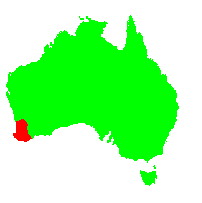General Description:
Banksia is a large genus of over 200 species in the Protea family, having been increased in size through the transfer of species in the former genus Dryandra to Banksia (see footnote box). The genus is almost exclusively Australian, being found in all States and Territories. A single species (B.dentata) is found in islands to Australia’s north as well as in tropical Australia.
Banksia dallanneyi forms part of the “Banksia nivea complex” and was, until recently, considered to be synonymous with B. nivea. In the revision of the genus Dryandra, Alex George restored D.lindleyana to species status and created six subspecies. As a result of the subsequent transfer of the genus Dryandra to Banksia, D.lindleyana was renamed Banksia dallanneyi as there is already a species known as Banksia lindleyana.
B.dallanneyi is a prostrate to low growing shrub often spreading with underground stems. It is fire tolerant, regenerating from an underground lignotuber after fires. The leaves are long and narrow, up to 200 mm long and deeply lobed in triangular segments. The individual small flowers occur in inflorescences containing 35-45 flowers. The inflorescences occur at the ends of branches, are orange-brown in colour and about 50 mm in diameter. The flowers are arranged in a ring and curve towards the central axis leaving a circular hole in the middle. Flowering occurs from mid winter to mid spring.
Various forms of B.dallanneyi have been grown for many years as B.nivea. The species is one of the more reliable species in cultivation, particularly in areas without humid, wet summers. All forms are attractive garden plants, particularly for rockeries. Because of the attractive foliage, the species attracts attention even when not in flower.
Propagation from seed is relatively easy and cuttings are also successful.
A paper published in 2007 proposed that the genus Dryandra be subsumed into Banksia. This revised classification has been accepted by the Council of Heads of Australasian Herbaria and the new Banksia names now appear on Florabase (the website for the Western Australian Herbarium) and in the Australian Plant Census.
The new classification has come in for some criticism but, as the Austraian Plant Census has been adopted as the authority on plant names by ANPSA, the revised classication has been accepted on the ANPSA website. The previous Dryandra names will also be mentioned where appropriate. For further information refer to our Banksia page.

Banksia dallanneyi (syn. Dryandra lindleyana)
Photo: Margaret Pieroni
Images of all species in the former genus Dryandra can be seen in the Dryandra Study Group’s Dryandra Image Gallery
 Australian Native Plants Society (Australia)
Australian Native Plants Society (Australia)













